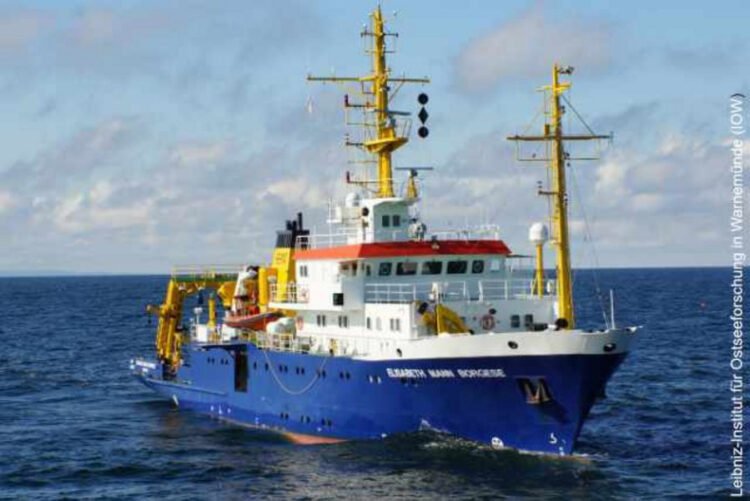New indicator for oxygen levels in early oceans developed

With the research vessel Elisabeth Mann Borgese, the research team set out to collect seawater samples in the Baltic Sea. The geologists hope to gain insights into the oxygen content of the early oceans by determining tungsten isotopes in ancient sediment samples.
Credit: Leibniz Institute for Baltic Sea Research Warnemünde (IOW)
Oxygen is essential for the development of higher life.
However, it was hardly present in the oceans of the young Earth. It was not until the evolution of photosynthetic bacteria that the oceans saw a significant increase in oxygen levels. By measuring tungsten isotope composition, an international research team with the participation of scientists from the University of Cologne’s Institute of Geology and Mineralogy has now laid the foundation for a more precise determination of the development of oxygen levels in the early oceans over time.
Prospectively, they expect more precise insights into the evolution of life. In cooperation with scientists from ETH Zurich, the Universities of Bern and Tübingen, and the Leibniz Institute for Baltic Sea Research Warnemünde (IOW), geologists led by Dr Florian Kurzweil at the University of Cologne analysed the chemical element tungsten, which could act as an indicator element for oxygen, in today’s seawater.
The results have been published in the Proceedings of the National Academy of Sciences (PNAS) under the title ‘Redox control on the tungsten isotope composition of seawater’. The research is part of the German Research Foundation’s priority programme ‘Building a Habitable Earth’.
Tungsten is present only in very small amounts in the oceans, making it difficult to accurately determine its concentration. It is even more difficult to determine the abundance of individual tungsten isotopes in seawater. Isotopes of an element have the same number of protons, but different numbers of neutrons. Hence, there are heavy tungsten isotopes with many neutrons and lighter tungsten isotopes with fewer neutrons. The analytical methods developed at the University of Cologne enable the most precise measurement of relative tungsten isotope abundances currently available worldwide.
In a basin more than 400 metres deep in the Baltic Sea, the research team took various water samples, both in the oxygen-rich surface water and in the oxygen-deficient deep water. Oxide minerals form along the boundary of both water layers, preferentially binding the light tungsten. The tungsten remaining in the seawater thus becomes relatively heavier. Oxygen is required to form oxide minerals, so the oxygen concentration of the oceans ultimately correlates with the tungsten isotope composition of the seawater.
‘Increasing oxygen concentrations in the oceans of the early Earth should have led to increased formation of the oxide minerals, and thus to isotopically heavier marine tungsten,’ said the head of the research expedition Dr Florian Kurzweil.
The scientists now want to show that this development has been preserved in marine sediments. The composition of tungsten isotopes of the oldest sediments on Earth could then trace the development of marine oxygen levels over the course of Earth’s history like a genetic fingerprint.
All latest news from the category: Earth Sciences
Earth Sciences (also referred to as Geosciences), which deals with basic issues surrounding our planet, plays a vital role in the area of energy and raw materials supply.
Earth Sciences comprises subjects such as geology, geography, geological informatics, paleontology, mineralogy, petrography, crystallography, geophysics, geodesy, glaciology, cartography, photogrammetry, meteorology and seismology, early-warning systems, earthquake research and polar research.
Newest articles
Faster, more energy-efficient way to manufacture an industrially important chemical
Zirconium combined with silicon nitride enhances the conversion of propane — present in natural gas — needed to create in-demand plastic, polypropylene. Polypropylene is a common type of plastic found…

Energy planning in Ghana as a role model for the world
Improving the resilience of energy systems in the Global South. What criteria should we use to better plan for resilient energy systems? How do socio-economic, technical and climate change related…

Artificial blood vessels could improve heart bypass outcomes
Artificial blood vessels could improve heart bypass outcomes. 3D-printed blood vessels, which closely mimic the properties of human veins, could transform the treatment of cardiovascular diseases. Strong, flexible, gel-like tubes…





















